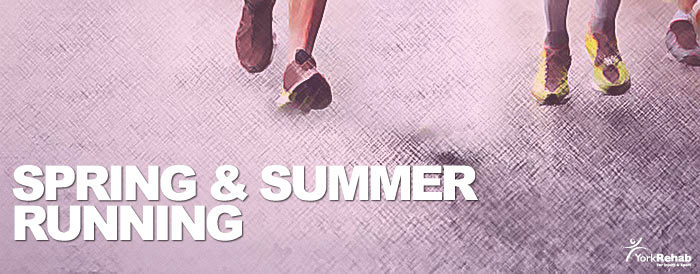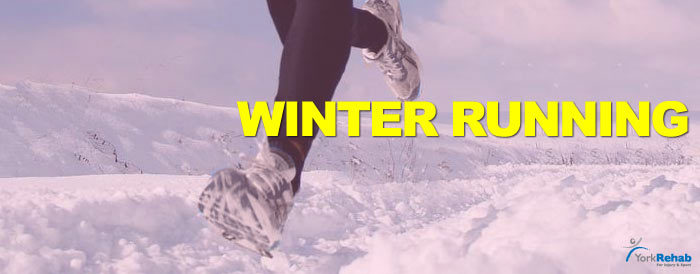Spring/Summer Running
Spring is here –time to follow-up on all of your New Year’s resolutions and dust off your sneakers!
Before we know it, summer will be upon us and the heat we’ve be yearning for all winter will finally be here.
Be sure to prepare for the summer conditions to ensure you succeed with all your summer running goals.
PRE-RUN:
- Monitor the weather forecast. Note the UV index to reduce your risk of harmful overexposure to radiation. In addition, pay attention to the Humidex as it incorporates both humidity and temperature. As a general rule with both indexes, the higher the number, the greater the need to exercise caution.
- Dress appropriately. “Cotton is rotten”, or so they say. Technical or quick-dry clothing are best, as they are lightweight, offer warmth without bulk and have effective properties to remove moisture away from the skin. Use the “Rule of 10” as a guide in choosing those layers -dress for temperatures 10 degrees warmer than that listed. To avoid overheating, you should feel cool as you head outdoors –you’ll feel warm within 10-15 minutes after starting of your run. Don’t forget important accessories such as a running hat or visor, in addition to sport sunglasses.
- Protect your feet. Check for tears and/or wear patterns on your shoes. The cushioning foam becomes compressed and/or breaks down after continued impact, resulting in reduced shock absorption. If you can’t remember the last time you purchased a new pair of shoes though, chances are, you need to go shopping! Running shoes should be replaced approximately every 800 kms.
- Run safe. Run with a buddy or, if you plan to run alone, notify others of your route and your expected departure and return times. Run in a series of loops and have a designated turn-around point should you need to cut your run short or seek shelter. Always run with identification and carry a cell phone in the event of an emergency.
MID-RUN:
- Monitor for early signs of heatstroke. This is the most serious heat-related illness. Prolonged exposure to high temperatures results in an elevated core temperature. This then causes a series of symptoms ranging from nausea, seizures, confusion, disorientation and sometimes loss of consciousness. In extreme cases, it can even cause death.
- Stay hydrated. With higher temperatures, your sweat production will increase. The evaporation of water from the skin by increased body heat is used as a means of temperature regulation. With increased loss of fluid, your risk for dehydration increases. Carry a water belt with you to replenish fluids lost –avoid extreme thirst!
POST-RUN:
- Perform a cool-down. Low intensity activity, promoting functional range of movement is recommended.
Should you require information and recommendations for exercising safely with a variety of health conditions consult a member of our Physiotherapy Team at YRA.
Running in the Winter
Why run in the winter? Current CSEP guidelines recommend adults (aged 18-64) accumulate a minimum of 150 minutes of moderate to vigorous intensity aerobic exercise per week. Recommendations are also made to add muscle and bone strengthening activities at least two days per week.
Running is a great sport to combine all of these recommendations.
Don’t hang up your shoes once the snow starts to fall though -if you’re prepared for the upcoming winter conditions you’ll be able to run all year long!
Pre-run:
- Monitor the weather forecast. Note the wind speed in addition to temperature. The steady flow of cold air can contribute to rapid cooling and subsequent “wind chill”.
- Dress in layers. Use the “Rule of 10” as a guide in choosing those layers -dress for temperatures 10 degrees warmer than that listed. Don’t forget important accessories such as a hat, balaclava, buff and gloves. Technical or quick-dry clothing is best, as they are lightweight, offer warmth without bulk and have effective properties to remove moisture away from the skin. To avoid overheating, you should feel cool as you head outdoors -you’ll feel warm within 10-15 minutes after starting of your run.
- Protect your feet. To increase traction in slippery conditions, you can purchase strap-on grippers which are attached to the soles the shoes you use year-round, or you can consider purchasing winter shoes with water-resistant uppers and deeper treads, or trail shoes. Technical or quick-dry socks can also help to keep your feet warm and dry.
- Make sure you’re lit. With the long nights of winter, darkness ensues. Be sure to include multiple points of reflection and/or light on your outer layers of clothing. View this video demonstrating what a driver sees at night with and without reflection: http://www.youtube.com/watch?v=-5k_AVjtHGA&feature=youtu.be
- Run safe. Run with a buddy or, if you plan to run alone, notify others of your route and your expected departure and return times. Run in a series of loops and have a designated turn-around point should you need to cut your run short or seek shelter. Always run with identification and carry a cell phone in the event of an emergency.
Mid-run:
- Start against the wind. This way you can benefit from the support of the tailwind on the last leg of the run when fatigue often an issue.
- Shorten your stride. It’ll improve your footing with icy conditions.
- Monitor for early signs of frosbite. Frostbite presents as pain with reddening of the skin. With continued exposure to the cold, this leads to the sensation of prickling and numbness.
- Stay hydrated. With lower temperatures, you will feel less thirsty. With less intake of fluids, your risk for dehydration increases. Carry a water belt with you to replenish fluids lost through perspiration and respiration. Tuck your belt under your jacket and you’ll be sure to prevent your water from freezing solid!
Post-run:
- Avoid a chill. After you have stopped running, your heat loss will outweigh your heat production. To minimize this effect, be sure wear a warm jacket until you return home, when you can remove all of your dampened layers of clothing.
- Perform a cool-down. Low intensity activity, promoting functional range of movement is recommended.
Should you require information and recommendations for exercising safely with a variety of health conditions consult a member of our Physiotherapy Team at YRA. For details on beginning a structured running program, visit www.runningroom.com







